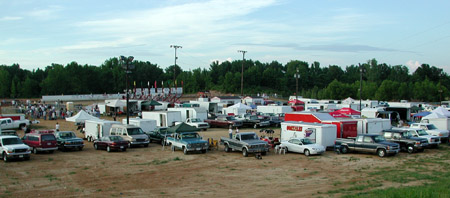|
Every
other summer Saturday the Atoka Raceway north of Memphis comes alive with
competitive kart racing. Fans, friends and family come to watch. Drivers
come to win. They come from Tennessee, Arkansas, Missouri, and Mississippi
. . . sometimes further.
The day starts at 2:00 pm. as racers pull their trucks and trailers
through the gates and stake out a |

|
|
territory. There they set
up their work areas. Lights are situated, generators are connected and
karts are rolled out.
Drivers from both sexes run their karts on the track at
assigned times to check the kart setup. Adjustments are then made based on
how the kart handled and readings from the tachometer. Competitive kart
racing is a sport and a science. Karts are put on four scales, one tire
on each. Weight jacks are adjusted, tire pressure is fine-tuned, and gear
ratio may be changed. Tires are washed and scrubbed. Then they are
sprayed with a solvent to soften them for better grip.
Heat races then ensue followed by feature races in
several classes. This particular day there were 135 entries. Each entry
costs $20 for all races except the survivor series. It costs $25. Everyone, including the drivers, pays $10 to attend. Winners walk away
with satisfaction and money. One special race – the 40 lap survivor
series – put $800 in the pocket of the 1st place finisher.
Most races are eight to ten laps for heat races and 12 to 15 laps for
feature races. |
The junior division has
six different classes for ages seven to 15. Some classes run with a
speed-limiting restrictor plate, others do not. Racers over 15 do not use
restrictor plates on their modified 5 HP engines. Lighter karts reach
speeds of about 55 miles an hour. Classes have a minimum weight for the
kart plus driver. Stock light is at least 305 pounds, stock medium is
335, and stock heavy is 360. There is also a class for drivers 35 years
old and up requiring a minimum weight of 360. The stock super-heavy class
requires a combined kart driver weight of 390 pounds and the driver has to
weigh 200 or more. The heaviest class is the Sr. Champs with a weight of
410 pounds.
As race time nears for a driver, he or she has the fuel
(methanol) siphoned from the tank by a track official. This fuel is mixed
with fuel from the other karts in the race. This mixed fuel is then put
back into each of the tanks by track officials. Karts are weighed after
the race to make certain the winners ran with required weight.
|
There are several safety features of the track, the karts,
and the drivers.
The track has lights in turns one and three to indicate “go”
(green), “caution” (yellow) or “stop” (red). There is also the flagman on
the starting platform and track officials on the infield. Karts must have
weights secured with two nuts and drivers must wear helmets, neck braces,
gloves, skid-resistant jackets, and elbow pads.
Veteran attendees pay little attention to these things. Their
concentration is on the karts as they roll around the track waiting for
the green flag to drop. The roar of the engines, the smell of the
exhaust, and the taste of the dust blowing into the stands mean the race
is on. Shortly after 1:00 a.m. the final checkered flag drops. Those
still at the track pack up and pull out the gates for home. Many will
repeat this process in another town the next Saturday. Seven days later
it will be back to Atoka at 2:00 p.m.
Click here for picture page
copyright, 2001, Tim Rand
|
